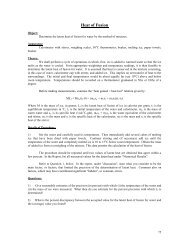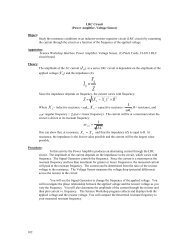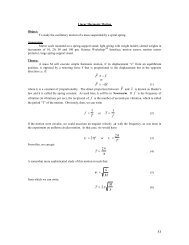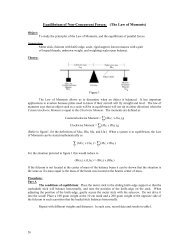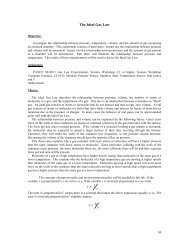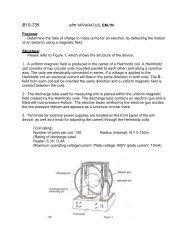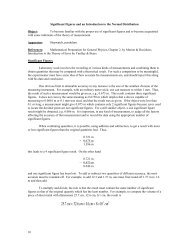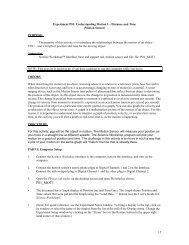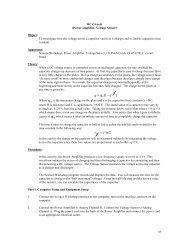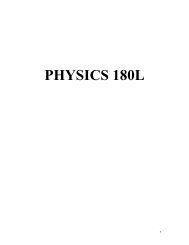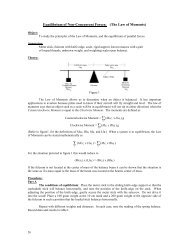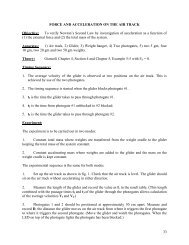Force and Acceleration on the Air Track pt 1_25Feb2013.pdf - Physics
Force and Acceleration on the Air Track pt 1_25Feb2013.pdf - Physics
Force and Acceleration on the Air Track pt 1_25Feb2013.pdf - Physics
You also want an ePaper? Increase the reach of your titles
YUMPU automatically turns print PDFs into web optimized ePapers that Google loves.
FORCE AND ACCELERATION ON THE AIR TRACKObjective: To verify Newt<strong>on</strong>’s Sec<strong>on</strong>d Law by investigati<strong>on</strong> of accelerati<strong>on</strong> as a functi<strong>on</strong> of(1) <strong>the</strong> external force <str<strong>on</strong>g>and</str<strong>on</strong>g> (2) <strong>the</strong> total mass of <strong>the</strong> system.Apparatus: 1) <strong>Air</strong> track, 2) Glider, 3) Weight hanger, 4) Two photogates, 5) two 5 gm, four10 gm, two 20 gm <str<strong>on</strong>g>and</str<strong>on</strong>g> two 50 gm weights.Theory: Serway/Jewett, Cha<strong>pt</strong>er 5, Secti<strong>on</strong> 4, 7 th editi<strong>on</strong>.Timing Sequence:1. The average velocity of <strong>the</strong> glider is observed at two positi<strong>on</strong>s <strong>on</strong> <strong>the</strong> air track. This isachieved by use of <strong>the</strong> two photogates.2. The timing sequence starts when <strong>the</strong> glider blocks photogate #1.3. t 1 is <strong>the</strong> time <strong>the</strong> glider takes to pass through photogate #1.4. t 3 is <strong>the</strong> time from photogate #1 unblocked to #2 blocked.5. t 2 is <strong>the</strong> time <strong>the</strong> glider takes to pass through photogate #2.Experiment:The experiment is carried out in two modes:1. C<strong>on</strong>stant total mass, where weight is transferred from <strong>the</strong> glider to <strong>the</strong> weight cradlekeeping <strong>the</strong> total mass of <strong>the</strong> system c<strong>on</strong>stant.2. C<strong>on</strong>stant accelerating mass, where weights are added to <strong>the</strong> glider <str<strong>on</strong>g>and</str<strong>on</strong>g> <strong>the</strong> mass <strong>on</strong> <strong>the</strong>weight cradle is ke<strong>pt</strong> c<strong>on</strong>stant.The experimental sequence is <strong>the</strong> same for both modes.1. Set up <strong>the</strong> air track as shown in fig. 1. Check that <strong>the</strong> air track is level. The glider shouldsit <strong>on</strong> <strong>the</strong> air track without accelerating in ei<strong>the</strong>r directi<strong>on</strong>.2. Measure <strong>the</strong> length of <strong>the</strong> glider <str<strong>on</strong>g>and</str<strong>on</strong>g> record <strong>the</strong> value as L in <strong>the</strong> result table. (This lengthcombined with <strong>the</strong> passage times t 1 <str<strong>on</strong>g>and</str<strong>on</strong>g> t 2 of <strong>the</strong> glider through <strong>the</strong> photogates allows calculati<strong>on</strong>of <strong>the</strong> average velocities V 1 <str<strong>on</strong>g>and</str<strong>on</strong>g> V 2 .)3. Photogates 1 <str<strong>on</strong>g>and</str<strong>on</strong>g> 2 should be positi<strong>on</strong>ed approximately 50 cm apart. The first photogate(photogate #1) is plugged into channel 1. Photogate is plugged into channel 2. Measure <str<strong>on</strong>g>and</str<strong>on</strong>g>record D, <strong>the</strong> distance <strong>the</strong> glider moves <strong>on</strong> <strong>the</strong> air track from where it triggers <strong>the</strong> first photogate33
to where it triggers <strong>the</strong> sec<strong>on</strong>d photogate. (Move <strong>the</strong> glider <str<strong>on</strong>g>and</str<strong>on</strong>g> watch <strong>the</strong> photogates. When <strong>the</strong>LED <strong>on</strong> top of <strong>the</strong> photogate lights <strong>the</strong> photogate has been blocked.)4. Weigh <strong>the</strong> glider <str<strong>on</strong>g>and</str<strong>on</strong>g> record your result in kilograms. Add <strong>the</strong> two 5 gm <str<strong>on</strong>g>and</str<strong>on</strong>g> four 10 gmweights to <strong>the</strong> glider <str<strong>on</strong>g>and</str<strong>on</strong>g> record <strong>the</strong> sum of <strong>the</strong> glider mass <str<strong>on</strong>g>and</str<strong>on</strong>g> <strong>the</strong>se weights as m in your tableof results. (The glider must be loaded symmetrically, i.e. equal mass <strong>on</strong> each side.)5. Attach <strong>on</strong>e end of <strong>the</strong> thread to <strong>the</strong> weight hanger <str<strong>on</strong>g>and</str<strong>on</strong>g> <strong>the</strong> o<strong>the</strong>r end to <strong>the</strong> hook <strong>on</strong> top of<strong>the</strong> glider.6. The weight hanger has an unloaded mass of .005 kg. This will be your first acceleratingmass <str<strong>on</strong>g>and</str<strong>on</strong>g> is recorded as m a in your table of results.7. Open “physics lab” program: <str<strong>on</strong>g>Force</str<strong>on</strong>g>_accelerati<strong>on</strong>_airtack.ds8. Hold <strong>the</strong> glider steady at <strong>on</strong>e end of <strong>the</strong> track <str<strong>on</strong>g>and</str<strong>on</strong>g> hang <strong>the</strong> thread over <strong>the</strong> pulley at <strong>the</strong>o<strong>the</strong>r end of <strong>the</strong> track. One student should release <strong>the</strong> glider <str<strong>on</strong>g>and</str<strong>on</strong>g> allow it to pass through bothphotogates. The o<strong>the</strong>r student should attem<strong>pt</strong> to catch <strong>the</strong> glider as it exits <strong>the</strong> sec<strong>on</strong>d photogate.(Be careful to ensure that it has passed completely through <strong>the</strong> photogate!) The computer willmeasure t 1 , t 2 <str<strong>on</strong>g>and</str<strong>on</strong>g> t 3 . Repeat this measurement four or five times <str<strong>on</strong>g>and</str<strong>on</strong>g> check c<strong>on</strong>sistency of yourresults. BE CAREFUL NOT TO BLOCK PHOTOGATE 1 BETWEENMEASUREMENTS. BE CAREFUL NOT TO TRIGGER THE PHOTOGATES WITHTHE STRING.Remove <strong>the</strong> glider from <strong>the</strong> air track to repositi<strong>on</strong> it for <strong>the</strong> next measurement.9. Vary m a by moving weights from <strong>the</strong> glider to <strong>the</strong> weight hanger (thus keeping <strong>the</strong> totalmass m + m a c<strong>on</strong>stant). Record <strong>the</strong> new values of m <str<strong>on</strong>g>and</str<strong>on</strong>g> m a <str<strong>on</strong>g>and</str<strong>on</strong>g> repeat steps 7-9. (Enter <strong>the</strong>Main Menu by choosing “X” <str<strong>on</strong>g>and</str<strong>on</strong>g> press “RETURN”.) Try at least four different values for m a ,e.g. 5 gm, 15 gm, 35 gm, <str<strong>on</strong>g>and</str<strong>on</strong>g> 55 gm.10. For <strong>the</strong> sec<strong>on</strong>d phase of <strong>the</strong> experiment, leave m a c<strong>on</strong>stant at some previously used value(e.g. 5gm). Vary m by adding or removing weights from <strong>the</strong> glider. Repeat steps 7-9. Recordyour data for each value of m, try at least four different values for m.Calculati<strong>on</strong>s:1) Use <strong>the</strong> length of <strong>the</strong> glider L <str<strong>on</strong>g>and</str<strong>on</strong>g> your measured times to determine V 1 <str<strong>on</strong>g>and</str<strong>on</strong>g> V 2, <strong>the</strong> averageglider velocity at each photogate.2) Determine F a, <strong>the</strong> force applied to <strong>the</strong> glider by <strong>the</strong> hanging mass. (F a = m a g; g=9.8 m/s 2 )3) Use <strong>the</strong> equati<strong>on</strong> a= (v 2 -v 1 )/( t 3 + t 1 /2+t 2 /2 ) to determine <strong>the</strong> average accelerati<strong>on</strong> of <strong>the</strong>glider as it passed between <strong>the</strong> two photogates.34
Data Table:Length of <strong>the</strong> glider: (L) = metersDistance between photogates: (D) = metersMass of unloaded glider: = gramsMass of <strong>the</strong> unloaded weight cradle: = 5 gramsPart I: C<strong>on</strong>stant Total MassMass <strong>on</strong>Glider(gms)CradleMassm a (gms)5C<strong>on</strong>stant Total Masst 1 t 2 t 3 v 1 (m/s)(L/ t 1 )v 2 (m/s)(L/ t 2 )a(m/s 2 )F a(N)1525354535
Part II: Changing Total massCradle Mass (m a ) = 5 gramsm = mass of unloaded glider + mass <strong>on</strong> <strong>the</strong> gliderMass <strong>on</strong>Glider(gms)406080100Total Mass(m+m a )(gms)Changing Total Masst 1 t 2 t 3 v 1 (m/s) v 2 (m/s) a(m/s 2 )Use <strong>the</strong> equati<strong>on</strong>a= (v 2 -v 1 )/( t 3 + t 1 /2+t 2 /2 )to determine <strong>the</strong> average accelerati<strong>on</strong> of <strong>the</strong> glider as it passed between <strong>the</strong> photogates.Questi<strong>on</strong>s:4) What would be <strong>the</strong> shape of <strong>the</strong> curve of a graph of height versus time of <strong>the</strong> experimentaldata?5) How would you determine <strong>the</strong> value of g from a graph using <strong>on</strong>ly height <str<strong>on</strong>g>and</str<strong>on</strong>g> timevalues…not computing V?6) In your opini<strong>on</strong> how well did <strong>the</strong> experimental data c<strong>on</strong>firm <strong>the</strong> expected results?7) Graph <strong>the</strong> accelerati<strong>on</strong> as a functi<strong>on</strong> of <strong>the</strong> accelerating force Fa= mag. Is <strong>the</strong> graph linear?8) Graph <strong>the</strong> accelerati<strong>on</strong> a in <strong>the</strong> c<strong>on</strong>stant ma experiment as a functi<strong>on</strong> of total mass m + ma.What is <strong>the</strong> relati<strong>on</strong>ship?36



